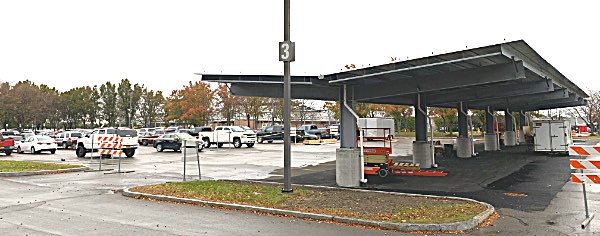- By Dan Veaner
- News
 Print
Print 
The new, improved Ithaca-Tompkins Airport is scheduled to open any day now. Construction on the project must be completed before the end of this year. But airports are works in progress, and this airport is no exception. When the project was announced Airport Manager Mike Hall said more than 3/4 of the airport's natural gas consumption would be replaced by solar energy and heat pumps. That would save about $50,000 per year on utility costs, even though the terminal is now 1/3 larger. But it also makes the terminal more reliant on electricity, and that has been problematic of late.
"The electric side of this is still NYSEG. We're hooked to the grid," Hall says. "When I went to the FAA for a meeting a couple of weeks ago and they said, well, you've got your terminal, you're moving the fuel farm, uh, you're building the flight Academy, building the new firehouse. What else do you want me? And I said, well, I want an electric circuit that is robust, redundant, and sustainable. We don't have that right now."
While the airport can't entirely stop using natural gas, at least for now, a more than 70% reduction in natural gas use will bring benefits to both the airport and to Lansing. Some natural gas is needed to heat areas that heat-pumps can't handle, such as the baggage area where garage doors are frequently opened and closed. But even retaining that smaller fraction of natural gas heating capacity, the savings in utility bills will be considerable. And Hall says that wile the official number is a 70+% savings, that refers to worst case scenarios.
"The bottom line is that on an average day, we're essentially going to use no gas except to cook hamburgers," he says. ". And if we choose to dial back on the recovery time it's much more than the 70%. So we're essentially off gas unless we have a really unusual situation."
The benefit to the Town and Village of Lansing is that in the midst of a moratorium on new natural gas customers, it frees enough natural gas capacity to bring natural gas to up to seven businesses that need it for manufacturing, or the equivalent of 70 homes. That is good news in a time when the Mayor of the Village of Lansing and the Town Supervisor have complained that the moratorium is driving new and expanding businesses away from Lansing.
The next challenge is reliable electricity. Recent surges and blackouts plaguing Lansing have caused damage to computers and other electronic devices, with a significant loss to the airport last summer when a $20,000 HVAC unit fell victim to power surges. Hall says he fears the next moratorium will be on electricity, and warns that grid reliability will be challenged even more as homes and businesses transition from natural gas to heat pumps, which need electricity to run.
Hall says that if he can create a reliable micro-grid that it will bring new possibilities for using green energy, such as electric baggage-tugs and parking lot electric car recharging stations. He says he wants that reliable circuit to be powered by a low carbon footprint, sustainable source.

Car charging stations may come sooner. The first of a planned series of solar panel units is under construction in the southeast corner of the short-term parking lot. While these will generate some power, they can't come close to the 1.5MWs the terminal needs.
"It's more of a visual commitment than it is a practical," Hall says. "However, I would say this: first of all it's improved parking because you've got a roof and I wanted the roof to have to generate something. Then the next thing is we're going to start adding electric charging stations. The plan is to build out that solar covered parking, a module at a time as we can afford it. And as the demand, particularly for electrical vehicles comes in because although we provisioned for charging stations when we built this we did not put them in because we are not sure what we should do is the, so the wiring is going in, Wiring is the infrastructure, the conduits there, so you don't have to tear the whole thing up (when you install the next ones). I hope by the time we built the second one of those, we will learn a little bit from building this and we will build the second one and put charging stations in both."
In the future Hall hopes the airport can run entirely on sustainable energy. To that end he has had preliminary talks with Cayuga Solar, the solar farm that has been proposed by the Cayuga Operating Company. That may not pan out, as COC officials have said that they want to use that solar array, if it is built, to help power their proposed data center. But Hall says if that doesn't work out there are other solar possibilities that are delivered over NYSEG's grid, which brings him back to the need for a reliable delivery system..
About 1.5 MWs are needed to power the terminal. At one point a company was exploring building a solar array on airport property across the air field. That fell through when the company was bought by a larger corporation, but in any event it wouldn't have been able to supply enough electricity to entirely power the terminal. So aside from the parking lot units and emergency generators, power will have to be delivered over the NYSEG grid.
As for the airplanes themselves, it will be a while before they stop using carbon fuels. Hall notes that the aviation industry contributes only 3% of the carbon load, but it contributes disproportionately because it takes so much energy to fly an airplane. Sustainable energy-driven passenger aircraft are farther into the future, but one way to reduce carbon fuel use is to fly larger aircraft that can hold more passengers at the same time.
As the airport grows, Hall says it may go from nine cycles each day (airplanes both arriving and departing make a cycle) to 12, but the size of the aircraft will grow,making fuel use somewhat more efficient.
"You're not going to see much of an increase in numbers on the commercial aviation side," Hall says. "But you will see an increasing gauge, which then relates to the PFCs. The 50 seat airplanes are going away. The next airplane is 65. We've got a 65-seater going to Charlotte now. So same number operations, hardly any difference from a standpoint of looking up and seeing the airplane or hearing the airplane or anything. In fact, usually it's quieter because later airplanes are all quieter."
Airports are always works in progress. While the customs facility will be completed by the end of this year, it won't be operational until early in 2020. That will transform the Ithaca-Tompkins Regional Airport into the Ithaca-Tompkins International Airport. The expanded terminal will have improved security facilities, and expanded check-in and concourse. Four of the gates will be served by jet bridges.
For the foreseeable future, a new fuel farm is expected to be completed next Spring. It will be located right at the airport fence so vehicles on both sides of the airport boundary can refuel there, including county vehicles, Sheriff Department vehicles, and vehicles from the new DOT facility across the street, as well as planes and other airport vehicles. Once the fuel farm is moved the current location will become the site of a new flight training academy. Hall says it is also possible that the airport may become a travel hub, where TCAT buses as well as tourist and interstate buses may offer service. Finally, the control tower will be relocated, because its current location conflicts with ground operations for the new concourse. It will likely relocate across the field, near the VOR (short range navigation radar beacon that looks like a traffic cone sitting on a disk) on the other side of the runway from the terminal.
While all this is happening Hall is exploring sources of renewable energy that one day will make the Ithaca-Tompkins International Airport carbon-free.
v15i45



